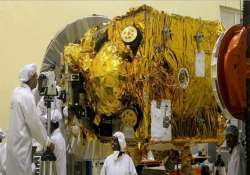Mars spacecraft sent to Sriharikota, launch on Oct 28
Bangalore: The Mars Orbiter Mission spacecraft was shipped out of Bangalore on Wednesday for Sriharikota to be launched on October 28. It will be a historic day for Indian space history. On reaching Sriharikota launchpad,

Bangalore: The Mars Orbiter Mission spacecraft was shipped out of Bangalore on Wednesday for Sriharikota to be launched on October 28. It will be a historic day for Indian space history.
On reaching Sriharikota launchpad, the stage for final preparations for the odyssey to the red planet will begun.
"It was put in a special container where we have the monitoring of the environment inside", an official of the Indian Space Research Organisation (ISRO) told PTI here.
Accompanied by a convoy, the truck-trailer carrying the container is currently on its way by road Sriharikota, where it's slated to reach tomorrow afternoon. Gandhi Jayanti day was chosen for the journey as traffic would be less.
A national committee of experts and pre-shipment review panel had earlier given their go-ahead for the Rs 450 crore ambitious venture.
Primary objectives of the mission are to demonstrate India's technological capability to send a satellite to orbit around Mars and conduct meaningful experiments such as looking for signs of life, take pictures of the red planet and study Martian environment.
Bangalore-based ISRO said the Rs 150-crore spacecraft would be launched on October 28 at 16 hours, 14 minutes and 45 seconds (4.15 pm), weather permitting.
Launch campaign has already commenced at the Satish Dhawan Space Centre in Sriharikota, about 90 km from Chennai, from where the 1,350-kg MOM spacecraft is slated to be launched by the Rs 110 crore Polar Satellite Launch Vehicle (PSLV-C25).
The first stage of the PSLV-C25 with strap-ons has already been assembled, with the rocket ready for satellite integration by October 10.
The satellite will carry compact science experiment instruments, totalling a mass of 15 kg. There will be five instruments to study Martian surface, atmosphere and mineralogy.
After leaving the earth's orbit, the spacecraft will cruise in deep space for about ten months using its own propulsion system and will reach Martian transfer trajectory in September 2014. The spacecraft subsequently is planned to enter into a 372 km by 80,000 km elliptical orbit around Mars.
The main theme of MOM appears to be to seek to reveal whether there is methane, considered a “precursor chemical” for life, on the red planet. Methane sensor, one of the five payloads (scientific instruments) on board the spacecraft, would look to detect the presence of Methane.
On reaching Sriharikota launchpad, the stage for final preparations for the odyssey to the red planet will begun.
"It was put in a special container where we have the monitoring of the environment inside", an official of the Indian Space Research Organisation (ISRO) told PTI here.
Accompanied by a convoy, the truck-trailer carrying the container is currently on its way by road Sriharikota, where it's slated to reach tomorrow afternoon. Gandhi Jayanti day was chosen for the journey as traffic would be less.
A national committee of experts and pre-shipment review panel had earlier given their go-ahead for the Rs 450 crore ambitious venture.
Primary objectives of the mission are to demonstrate India's technological capability to send a satellite to orbit around Mars and conduct meaningful experiments such as looking for signs of life, take pictures of the red planet and study Martian environment.
Bangalore-based ISRO said the Rs 150-crore spacecraft would be launched on October 28 at 16 hours, 14 minutes and 45 seconds (4.15 pm), weather permitting.
Launch campaign has already commenced at the Satish Dhawan Space Centre in Sriharikota, about 90 km from Chennai, from where the 1,350-kg MOM spacecraft is slated to be launched by the Rs 110 crore Polar Satellite Launch Vehicle (PSLV-C25).
The first stage of the PSLV-C25 with strap-ons has already been assembled, with the rocket ready for satellite integration by October 10.
The satellite will carry compact science experiment instruments, totalling a mass of 15 kg. There will be five instruments to study Martian surface, atmosphere and mineralogy.
After leaving the earth's orbit, the spacecraft will cruise in deep space for about ten months using its own propulsion system and will reach Martian transfer trajectory in September 2014. The spacecraft subsequently is planned to enter into a 372 km by 80,000 km elliptical orbit around Mars.
The main theme of MOM appears to be to seek to reveal whether there is methane, considered a “precursor chemical” for life, on the red planet. Methane sensor, one of the five payloads (scientific instruments) on board the spacecraft, would look to detect the presence of Methane.